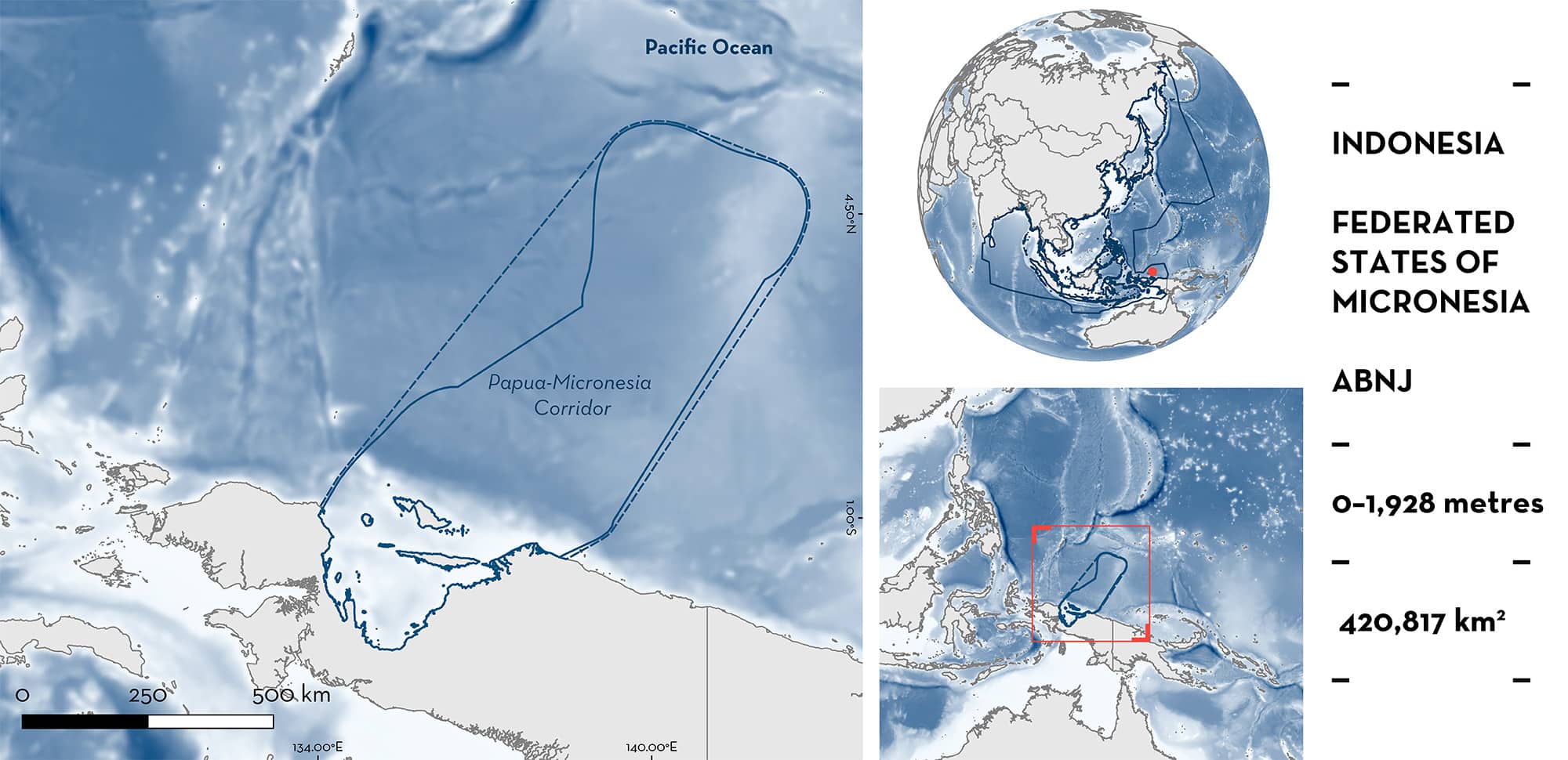ISRA FACTSHEETS
ISRA FACTSHEETS
ASIA REGION
Papua-Micronesia Corridor
Summary
Papua-Micronesia Corridor is located within national waters of Indonesia, Federated States of Micronesia, and areas beyond national jurisdiction (ABNJ). It includes productive coastal waters in north Papua and oceanic waters in the Bismarck Sea and the North Pacific. The area overlaps with one Ecologically or Biologically Significant Marine Area, two Key Biodiversity Areas, and three marine protected areas. Within the area there are: threatened species and areas important for movement (Whale Shark Rhincodon typus).
Download factsheet
Papua-Micronesia Corridor
DESCRIPTION OF HABITAT
Papua-Micronesia Corridor is located within the Exclusive Economic Zones (EEZ) of Indonesia and the Federated States of Micronesia and expands into areas beyond national jurisdiction (ABNJ). It spans coastal waters in north Papua, including Cenderawasih Bay, and is characterised by large river discharges that contribute to high productivity (Prentice & Hope 2007). Oceanic waters are within the Pacific Warm Pool which are characterised by sea surface temperatures (SST)>28°C.
The area is strongly influenced by monsoon seasons. During the northwest monsoon (November–March) warmer SST and intense precipitation are common, while during the southeast monsoon (May–October), SST in the area is colder, rainfall decreases, and strong winds are common (Prentice & Hope 2007).
The area overlaps with the Remetau group: South-West Caroline Islands and Northern New Guinea Ecologically or Biologically Significant Marine Area (EBSA; CBD 2024). It also overlaps with two Key Biodiversity Areas (KBA): Pacific, Western Central 2 – Marine and Pacific, Western Central 4 – Marine (KBA 2024a, 2024b). In addition, it overlaps with three marine protected areas, Teluk Cendrawasih Marine National Park, KKPN Padaido Marine Recreational Park, and KKPD Biak Nimfor.
This Important Shark and Ray Area is pelagic and is delineated from inshore and surface waters (0 m) to 1,928 m based on the global depth range of the Qualifying Species.
CRITERION A
VULNERABILITY
One Qualifying Species within the area is considered threatened with extinction according to the IUCN Red List of Threatened Species. The Whale Shark is assessed as Endangered (Pierce & Norman 2016).
CRITERION C
SUB-CRITERION C4 – MOVEMENT AREAS
Papua-Micronesia Corridor is an important movement area for one shark species.
Between 2016–2023, 34 Whale Sharks measuring 300–700 cm total length (TL) were tagged at Cenderawasih Bay with satellite transmitters (Konservasi Indonesia unpubl. data 2023). Tagged individuals moved back and forth from coastal aggregation and feeding sites in Papua to areas in the Bismarck Sea and the North Pacific Ocean, with incursions into the EEZ of the Federated States of Micronesia and into international waters. A few individuals moved to areas within the EEZ of Palau and the Marshall Islands, but these movements were not regular or predictable (Meyers et al. 2020; Sianipar 2022; Meyers 2023; Konservasi Indonesia unpubl. data 2023).
Tagged sharks did not depart in a specific season to offshore areas but moved to eastern parts of the bay and Papua from November to March and to western parts of the bay from May to October (Meyers 2023; Konservasi Indonesia unpubl. data 2023). While in coastal areas, individuals stayed mostly in shallow waters (<50 m), whereas in oceanic waters they moved at greater depths (>250 m), probably related to feeding in mesopelagic waters at night (Sianipar 2022; Meyers 2023). Whale Sharks spend most of the time within coastal areas at temperatures >28°C while in offshore areas they are distributed at lower temperatures (18–28°C; Meyers 2023; Konservasi Indonesia unpubl. data 2023).
Download factsheet
SUBMIT A REQUEST
ISRA SPATIAL LAYER REQUEST
To make a request to download the ISRA Layer in either a GIS compatible Shapefile (.shp) or Google Earth compatible Keyhole Markup Language Zipped file (.kmz) please complete the following form. We will review your request and send the download details to you. We will endeavor to send you the requested files as soon as we can. However, please note that this is not an automated process, and before requests are responded to, they undergo internal review and authorization. As such, requests normally take 5–10 working days to process.
Should you have questions about the data or process, please do not hesitate to contact us.


